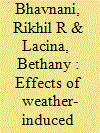| Srl | Item |
| 1 |
ID:
141819


|
|
|
|
|
| Summary/Abstract |
Migration is thought to cause sons of the soil conflict, particularly if natives tend to be unemployed. Using data from India, the authors investigate the causal effect of domestic migration on riots by instrumenting for migration using weather shocks in migrants’ places of origin. They find a direct effect of migration on riots, but do not find that this effect is larger in places with more native unemployment. They argue and find evidence that migration is less likely to cause rioting where the host population is politically aligned with the central government. Politically privileged host populations can appease nativists and reduce migration through means that are less costly than rioting. Without these political resources, hosts resort to violence. Beyond furthering the sons of the soil literature, the authors detail a political mechanism linking natural disasters and, possibly, climate change and environmental degradation to riots, and demonstrate a widely applicable strategy for recovering the causal effect of migration on violence.
|
|
|
|
|
|
|
|
|
|
|
|
|
|
|
|
| 2 |
ID:
144460


|
|
|
|
|
| Summary/Abstract |
Why are large population movements conflict-prone in some regions while they remain peacefully integrated elsewhere? I argue that clashes between ethnically distinct indigenous populations and migrants – i.e. ‘Sons of the Soil (SoS) conflict’ – erupt when there are large socio-economic and political horizontal inequalities between ‘dominant migrants’ and locals. A comparative case study of two Chinese minority regions based on ethnographic fieldwork and population data provides a vivid illustration of the mechanisms linking migration to SoS conflict. With fewer HIs between migrants and locals, Inner Mongolia avoided many of the violent clashes that were commonplace in Qinghai, a province fraught with disparities.
|
|
|
|
|
|
|
|
|
|
|
|
|
|
|
|